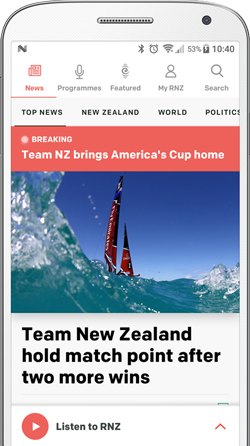Follow Our Changing World on Apple, Spotify, iHeartRadio or wherever you listen to your podcasts
An underwater 'predator-proof fence' is successfully protecting one of Auckland's rarest and most important freshwater species from the impacts of pest fish.
Kākahi, native freshwater mussels, play an important role in freshwater ecosystems by keeping the water clean. A single mussel can filter up to one litre of water every hour, according to Madison Jones, senior healthy waters specialist at Auckland Council.
A range of threats - including pollution, changes in water levels and flows, and the spread of invasive plants and animals - have negatively impacted kākahi populations.

Lake Rototoa. Photo: Ellen Rykers / RNZ
Lake Rototoa, near the entrance to Kaipara Harbour, is home to one of the Auckland region's healthiest populations of kākahi species Echyridella menziesii. But even this stronghold is in trouble.
The 'oh no' surveys
When Auckland Council divers first started surveying Lake Rototoa, they found plenty of native freshwater mussels across the lakebed.
"At first we were like, oh yeah, this is great," says Ebi Hussain, a diver from Submerged Environmental. "You could see shells scattered all over the place in fairly high densities. So, the assumption was that the mussel beds were still in good health."

Kākahi. Photo: Ellen Rykers / RNZ
But upon looking closer, they realised that 85% of the mussels were dead. Plus, the survivors were all old. The lack of young mussels indicated that breeding hadn't been successful for some time.
Across 17 lakes surveyed in Auckland, just two had surviving kākahi in reasonable numbers. Urgent action was needed to prevent their complete extinction in the region.
The problem with perch
In Lake Rototoa, multiple pest fish species have been interfering with the complex, multi-step kākahi breeding cycle.
During spawning, kākahi release tiny baby mussels called glochidia into the water. To survive and grow, these glochidia use little hooks to latch onto a native fish called a bully.

Tiny glochidia (baby kākahi) hitch a ride on a native bully. Photo: Auckland Council
But the bullies are being eaten by a pest fish called perch. To evade these predators, bullies have abandoned their usual sunny hangouts and retreated to the reeds.
"They're hiding from the from the perch, and because of that, the bullies and the kākahi are not interacting," says Belinda Studholme, senior biosecurity advisor for freshwater at Auckland Council.

Belinda Studholme (left) and Madison Jones counting baby mussels (glochidia) attached to native bullies. Photo: Ellen Rykers / RNZ
No bullies, means no baby mussels survive. But even if the glochidia do attach, they're not out of the woods yet.
After dropping off their host, they burrow into the sand. Here, they might be eaten or disturbed by another pest fish called a tench, which feeds by digging into the sediment.
A Goldilocks zone
The Auckland Council team determined that removing perch and tench completely from the lake wasn't feasible with the tools we currently have.
Instead, they've built the underwater version of a mini predator-proof fence, keeping the pest fish away from the kākahi and the bullies.

The kākahi enclosure at Lake Rototoa. Photo: Ellen Rykers / RNZ
"If I had to sell it to a six-year-old, we've put a net in the lake and created a little healthy lake. We call it the Goldilocks zone," says Madison.
Successive trials of Goldilocks enclosures since 2021 have allowed translocated dense beds of kākahi to successfully spawn, with hundreds of glochidia recorded attaching to bullies.
In contrast, the team have never found even a single baby mussel attached to a fish outside an enclosure.

Divers Ebi Hussain (in orange) and Andrew Simpson collect mud samples from the bottom of Lake Rototoa, handing them to Belinda Studholme for processing. Photo: Ellen Rykers / RNZ
In January 2025, mud samples collected from one of the earliest (now decommissioned) enclosures revealed that the protected kākahi have successfully reached the next life cycle stage too: tiny baby mussels no bigger than a chickpea have been retrieved from the lakebed.
After four to five years, the mussels will reach maturity and pop out of the sediment to begin water filtering - a job they continue across their 50-60-year lifespan that is integral to the health of the entire lake ecosystem.

Madison Jones (left) and Belinda Studholme wrangle mud samples collected from the bottom of an old enclosure. Photo: Ellen Rykers / RNZ
A hidden treasure
These results are promising, but there's more to do to upscale, says Madison. Still, it's worth it to protect a special place like Lake Rototoa, a refuge for many native species.
"If you could put your head underneath Lake Rototoa and see the beautiful plants and understand what a unique ecosystem it is, I genuinely believe people would care the same way they do when they walk around the Waitākere. It's just it's harder to connect with because it's underwater," she says.
"If you haven't explored your local stream or lake, go and have a look. Because there's so much life, and it's really important that we all know what's there so that we can protect it."

A native freshwater bully, the host fish for kākahi. Photo: Ellen Rykers / RNZ
Sign up to the Our Changing World monthly newsletter for episode backstories, science analysis and more.


